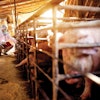
Image courtesy of DuPont Animal Nutrition
The poultry sector has made many improvements over the years to reduce its environmental impact. However, some issues remain, including the need to supplement feeds with inorganic phosphorus, an unsustainable resource with a negative environmental impact. For instance, producing 1-tonne monocalcium phosphate (MCP) corresponds to ~750 kg of emitted CO2 [1].
Inorganic phosphorus: an old issue that resonates today
Phosphorus is an essential dietary nutrient for broilers. It supports healthy growth, bone development, and proper nerve function particularly early on during chick-rearing, but also aids energy conversion as well as egg production [2, 3]. To avoid phosphorus deficiencies, feed is normally formulated with safety margins [4], which translates into higher feed costs and reduced profitability. In addition, this causes excess phosphorus to be excreted in the form of manure, seeping into the soil, and groundwater with negative environmental consequences [5].
As the global awareness of environmental footprint grows, producers must modify and improve feed formulations to meet nutritional requirements and simultaneously reduce the environmental impact of farm operations.
Phytase: an on-going (r)evolution
In all-vegetable broiler feeds, which are increasingly common globally, most phosphorus is present as phytate, a largely unavailable form of this nutrient. Thus, to meet phosphorus requirements, nutritionists need to add inorganic phosphorus and phytase to feed formulas. Phytase is beneficial as this enzyme breaks down phytate and makes phytatephosphorus available to the animal. Phytase addition reduces the need for inorganic phosphate supplementation [6, 7]. Yet, until today, phosphate supplementation could not be fully eliminated from commercial feed formulations in broilers, especially during the starter phase (1-10 days of age).
The starter phase poses the biggest challenge for the total removal of inorganic phosphorus from broiler feeds. The recommended digestible phosphorus requirement for broiler feed varies from 0.42% to 0.45%. Depending on the diet formulation, the digestible phosphorus contribution from ingredients, such as cereals, is between 0.12% and 0.15%. This means that more than 0.25% of the digestible phosphorus needs to be delivered by phytase activity. However, 0.25% is significantly higher than the matrix value of any commercial phytase currently available in the market for dose levels between 500 and 1500 FTU/kg.
For the first time, the total replacement of inorganic phosphate from day 1 in broilers fed all-vegetable diets has been shown to be a viable possibility: Axtra® PHY GOLD has the potential to nullify the need for inorganic phosphorus additives.
Our novel approach
We carried out a project at Texas A&M University to determine whether inorganic phosphorus-free (IPF) vegetable broiler diets are possible with a highly efficient phytase supplementation while maintaining growth performance and bone development throughout all development phases (Figure 1).
 Image courtesy of DuPont Animal Nutrition
Image courtesy of DuPont Animal NutritionWithin the project, two separate trials were conducted to assess the efficacy of Axtra® PHY GOLD in high phytate diets (>0.33%) with all iP removed and a Ca matrix applied, with and without phase-specific dosing and in combination with Danisco® Xylanase (Table 1).
 Image courtesy of DuPont Animal Nutrition
Image courtesy of DuPont Animal NutritionMaintaining performance goals
Supplementation at 1000 FTU/kg, compared to the positive control, resulted in improved or equal growth performance and feed efficiency in diets containing no iP and reduced in calcium according to the product matrix recommendations (IPFa). These results demonstrate that Axtra® PHY GOLD can fully replace inorganic phosphorus supplementation in broiler diets.
Axtra® PHY GOLD in combination with Danisco® Xylanase (IPFc) with additional energy reduction showed statistically similar results of final bodyweight and FCR to higher doses of Axtra® PHY GOLD on its own (IPFb) (Figure 2). The phase dosing strategy of 3000, 2000, and 1000 FTU/kg in starter, grower, and finisher phases respectively (IPFb), further improved bodyweight and FCR vs PC.
 Image courtesy of DuPont Animal Nutrition
Image courtesy of DuPont Animal Nutrition Image courtesy of DuPont Animal Nutrition
Image courtesy of DuPont Animal NutritionBone ash and breaking strength are key indicators of the ability of a phytase to make phosphorus available to broilers. Aside from outperforming its direct competitors (data available upon request), Axtra® PHY GOLD’s superior bioefficacy was also validated in these experiments during the starter phase of broiler development.
For instance, bone-breaking strength of broilers fed with the inorganic phosphorus-free diet supplemented with the highest starter phytase dose (3000 FTU, IPFb) or 2000 FTU phytase + Danisco® Xylanase (IPFc) significantly surpassed the results of the positive control in the first study and was equivalent in the second study (Figure 3).
 Image courtesy of DuPont Animal Nutrition
Image courtesy of DuPont Animal NutritionThese results demonstrate that Axtra® PHY GOLD can successfully replace all inorganic phosphorus supplementation while maintaining bone mineralization.
This is crucial as a negative impact on bone mineralization would pose a welfare issue, causing lameness in the flock, and has been a key barrier to attempting IPF diets.
Read the complete article here.
Author: L. Marchal, Y. Dersjant-Li, R.M. Hardy, A. Bello Technical Marketing & Innovation.
